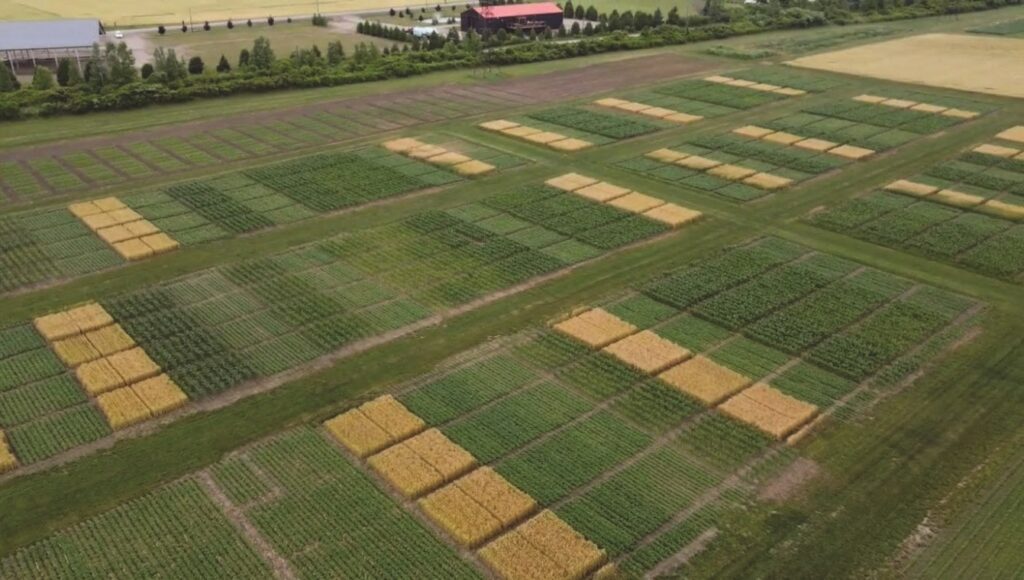Building soil health over time
LONG-TERM STUDY OF TILLAGE, FERTILITY, AND MORE

CUTTING-EDGE RESEARCH INTO SOIL HEALTH continues in Ontario, led by a University of Guelph team.
“Healthy, resilient soil is key to maintaining crop productivity,” notes Dr. Laura Van Eerd, professor of sustainable soil management at the University of Guelph. “This is particularly true in extreme weather years where drought or excessive moisture conditions are exacerbated in poor, degraded soils.”
Van Eerd has been conducting a long-term soil health study with the help of a large, hardworking team. “My research program is only possible because of graduate students such as Yajun Peng, post- doctoral fellow Dr. Inderjot Chahal, and colleagues Dr. David Hooker and Sean Vink,” she explains. “Sean is our research technician who provides leadership through understanding how to farm and conduct research at the same time and is an outstanding resource.” This research was funded in part by the Ontario Agri-Food Innovation Alliance, a collaboration between the Government of Ontario and the University of Guelph.
For years, Van Eerd’s team has been quantifying changes in soil health over time using indicators such as soil organic carbon (SOC) and total nitrogen (TN) storage level, which can vary in quantity due to tillage system, crop rotation, cover crop use and N application.
It is important to understand the role of these management practices on SOC and TN (soil health) so that growers can make crop productivity gains and maximize profits. Also, SOC measurements may allow Ontario growers to trade in carbon credits in the future. “However, meaningful Ontario data is needed,” says Van Eerd, “and the long-term tillage system-crop rotation-nitrogen trial at Ridgetown is well suited to provide this information.” The trial was initiated in 1995 on clay loam soil in a split-split plot design with four replications.
Using this experimental site, the team proposed to assess the differences in SOC and TN among crop rotations such as corn-corn, soybean-soybean, corn-soybean-wheat, or soybean-wheat, tillage system effects (zone-tillage versus conventional fall plow with spring secondary tillage), and the effect of N rate in the corn and wheat phases of the crop rotation. They also wanted to measure levels of SOC and TN by identifying sequestration rates and changes in storage from 2006 to 2019.
Other questions were: How much carbon storage can we expect when we have a red clover cover crop after wheat, and from N fertilizer rate effects in the crop rotation? And how can we define the relationship between soil health and crop yield (and variability in yield over time, also called resiliency) under various management practices?
RESULTS
Here are a few takeaways for Ontario grain farmers from the study analysis. The effects of crop rotation on soil health are still being analyzed, but some conclusions in this area are available.
1) Building SOC through crop rotation depends on type of tillage system.
This means that there is no ‘one-size’ fits all approach to increasing SOC storage.
2) No-till systems, in general, build soil health.
Many studies have shown that no-till leaves the soil structure and organism communities intact, promoting soil health. This study also showed that the modified no-till system had a greater potential in building soil health (building SOC and TN levels) than conventional tillage, fall moldboard plow, at all soil depths. Particularly in the top 20 centimetres of soil, the SOC level was much higher (14.1 Mg/hectare greater) with no-till. “How much this is due to more extensive roots versus crop debris is a question I and many international researchers want to answer,” says Van Eerd. “This project was not designed to answer that, but other research is suggesting we’ve undervalued how much carbon is below ground in roots, root exudates and in the rhizosphere microbe community.”
It is worth remembering that reduced tillage approaches protect the soil from erosion. By keeping soil in the field SOC and total N also remain in the field. This is one way to ‘build’ soil health in reduced tillage systems.
3) Potential of red clover to build SOC depends on amount of N applied.
Hooker explains that the potential for underseeded red clover to build SOC depends on good red clover stands, but the results in this trial show red clover biomass depends highly on the amount of fertilizer N applied to the wheat. “This is a confounding effect,” he notes, “and further explorations are underway to tease apart this interaction.”
GENERAL CROP PRACTICE GUIDANCE
Crop rotation, tillage system, and nitrogen rates may have a greater influence on SOC and total N levels; however, detecting changes is challenging due to the inherent variability in soil sampling over time and spatially across different cropping systems.
“This lack of effects could be due to many things, including a relatively short time, 13 years, of sampling to observe carbon stocks increase,” says Van Eerd. “It could also be due to a plateau in the rate of organic carbon accumulation or soil saturation (where no additional SOC storage would be expected) or a combination. Research is underway with Dr. Adam Gillespie to explore other possible reasons, such as partitioning of carbon in particulate organic matter and mineral- associated organic matter in surface soil.”
Nevertheless, Van Eerd and her colleagues recommend that the research is consistent with the principles of Ontario’s ‘Soils For Life’ program — recognizing that each farm is different. These principles are to build SOC over time, keep the soil covered, minimize soil disturbance (no-till or strip-till when possible), diversify crop rotations (as well as animals), and keep living roots all year.
FOR MORE
Van Eerd worked with her ‘Soils at Guelph’ team to explain soil carbon, a task that is especially difficult in agricultural soils. Find out more at soilsatguelph.ca. •

























